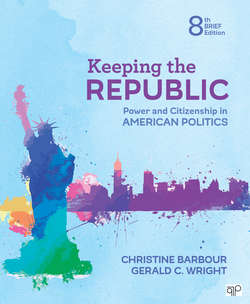Читать книгу Keeping the Republic - Christine Barbour - Страница 128
На сайте Литреса книга снята с продажи.
Descriptions of Images and Figures
ОглавлениеBack to Figure
A diagram listing the constitutional division of powers between the federal government and the states. Concurrent powers are also included.
National Powers:
Admit new states into the union
Coin money
Regulate commerce with foreign nations and among the states
Declare war
Raise and maintain armies, navies
Conduct foreign affairs
Establish courts inferior to the Supreme Court
Make laws that are necessary for carrying out the powers vested by the Constitution
State Powers:
Regulate intrastate commerce
Maintain militia (National Guard)
Provide for public health, safety, and morals
Ratify amendments to the federal Constitution
Conduct elections and determine voter qualifications
Establish local governments
Concurrent Powers:
Borrow and spend money for the general welfare
Charter and regulate banks; charter corporations
Collect taxes
Pass and enforce laws
Take private property for public purposes, with just compensation
Establish highways
Establish courts
States expressly prohibited from:
Abridging the privileges or immunities of citizens or denying due process and equal protection of the laws (Fourteenth Amendment)
Coining money
Entering into treaties
Keeping troops or navies
Levying import or export taxes on goods
Making war
Back to image
A highly partisan political cartoon. President Franklin Roosevelt is shown happily steering the American ship of state toward economic recovery. A dark cloud labeled “depression” hangs in the distance with big businessmen labeled “detractors” underneath. A sailor labeled “the American people” looks out on the horizon to a rainbow labeled “recovery.”
Back to image
A political cartoon. Uncle Sam is shown holding a sack of federal benefits in one hand and a document that reads “federal authority” in the other. A smaller man wearing a jacket that reads “states’ rights” is accepting the federal benefits but rejecting the federal authority. The caption reads, “In two words, yes and no.”
Back to image
A map of the United States illustrating each state’s dominant political ideology, and if the state receives more in benefits than it receives in taxes (net winners or net losers).
The following states are ranked as “Most Conservative”: South Carolina, Georgia, Alabama, Tennessee, Mississippi, Louisiana, Arkansas, Texas, Oklahoma, Nebraska, North Dakota, Wyoming, Utah, Idaho
The following states are ranked as “More Conservative”: North Carolina, West Virginia, Kentucky, Indiana, Missouri, Kansas, Iowa, South Dakota, Montana, Nevada, and Alaska
The following states are ranked as “More Liberal”: Pennsylvania, Delaware, Virginia, Florida, Ohio, Michigan, Illinois, Wisconsin, Minnesota, Colorado, New Mexico, and Arizona. Washington, D.C., is also categorized as “More Liberal.”
The following states are ranked as “Most Liberal”: Maine, New Hampshire, Vermont, Massachusetts, New York, Rhode Island, Connecticut, New Jersey, Maryland, California, Oregon, Washington, and Hawaii.
In general, most of the southern and midwestern states are predominantly conservative, and most of the northeastern and western states are predominantly liberal.
The following states are ranked as “Net Takers”: Maine, Delaware, Maryland, Pennsylvania, Virginia, West Virginia, North Carolina, South Carolina, Florida, Georgia, Alabama, Mississippi, Tennessee, Kentucky, Indiana, Michigan, Wisconsin, Iowa, Missouri, Arkansas, Louisiana, Arizona, Nevada, Montana, Idaho, Washington, Oregon, Alaska, Vermont, Rhode Island, Ohio, South Dakota, Kansas, Oklahoma, Colorado, Utah, and Hawaii.
The following states are ranked as “Net Payers”: Texas, California, Nebraska, New Hampshire, Illinois, Minnesota, Massachusetts, Wyoming, New York, Connecticut, North Dakota, and New Jersey.
